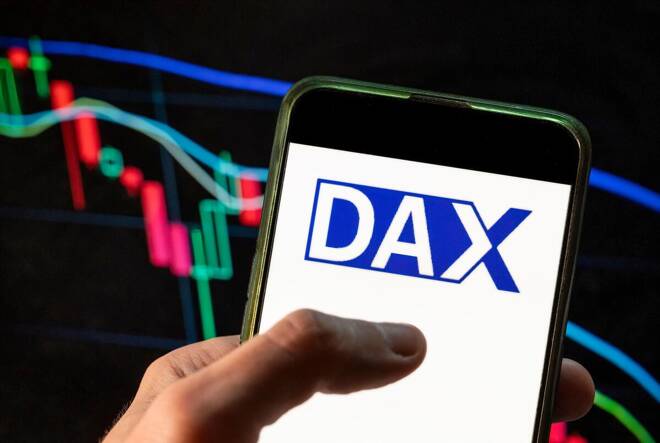Advertisement
Advertisement
DAX Index News: Looming US Labor Market Data Ends 10-Day Winning Streak
By:
Key Points:
- DAX ends a ten-session winning streak, closing down 0.35% on Tuesday as Siemens Energy leads a broad market retreat.
- Eurozone inflation edged up to 2.6% in July, challenging ECB rate cut expectations and pressuring DAX stocks.
- US labor market concerns grew as Fed scrutiny intensifies; DAX outlook hinges on upcoming economic data releases.
Market Overview
On Tuesday, August 20, the DAX declined by 0.35%, partially reversing the previous day’s 0.54% gain, closing at 18,358. Notably, the DAX ended its ten-session winning streak.
Tuesday: DAX Market Movers
- Siemens Energy led the decline, sliding by 3.50% amidst a broad-based energy sector retreat.
- Commerzbank and Deutsche Bank saw losses of 1.63% and 1.25%, respectively, reflecting rising uncertainty about the US economy.
German Producer Prices Match Forecasts
On Tuesday, August 20, German producer prices declined by 0.8% year-on-year in July after falling by 1.6% in June. The less pronounced decline signaled an improving demand environment. Producers increase prices in a rising demand environment, possibly transferring costs to consumers.
Eurozone Inflation Challenges ECB Rate Cut Bets
Finalized inflation figures for the Eurozone impacted demand for DAX-listed stocks on Tuesday.
The annual inflation rate increased from 2.5% in June to 2.6% in July, which could potentially influence the ECB’s rate path. Persisting inflationary pressures may delay ECB rate cuts. A delay in rate cuts could maintain higher borrowing costs, impacting corporate profits.
Expert Views on Eurozone Inflation and the ECB
Pictet Wealth Management Head of Macroeconomic Research Frederik Ducrozet commented on core inflation numbers for the Eurozone, stating,
“Good news on the margins in today’s final euro area HICP report. Core HICP was revised slightly lower (to 0.25% MoM SA), and most measures of underlying inflation eased further in July, getting closer to target.”
US Market Trends
On Tuesday, August 20, the US equity markets ended the session in negative territory, as concerns about the US labor market drove profit-taking. The Nasdaq Composite Index declined by 0.33%, ending its eight-day winning streak. Moreover, the S&P 500 and the Dow saw declines of 0.20% and 0.15%, respectively.
US Economic Calendar
On Wednesday, August 21, the market focus will be on the US labor market and the Fed as the Jackson Hole Symposium looms.
The US Bureau of Labor Statistics will release its preliminary revisions to payroll data over the 12 months to March 2024. Economists expect the revisions to reflect a sizeable overstatement in previous data, which could impact market risk sentiment.
Market sensitivity to the report could intensify amid increasing Fed scrutiny of the US labor market. Sizeable revisions could rekindle fears of a hard US landing, possibly impacting demand for riskier assets.
The Fed will release the FOMC Meeting Minutes from the July 30-31 meeting after the European market close.
Expert Views on the US Labor Market
Wall Street Journal Chief Economics Correspondent Nick Timiraos remarked on the recent NY Fed Survey, stating,
“NY Fed survey shows the share of individuals who reported searching for a job increased to the highest level in the 10-year history of the survey. Among those with jobs, the average expected likelihood of becoming unemployed also jumped to a series high.”
Near-Term Outlook
Near-term DAX trends will hinge on central bank commentary, US labor market data, and Thursday’s Services PMI numbers. Weaker-than-expected US data could retrigger fears of a hard US landing, impacting DAX-listed stocks. Speeches from the Jackson Hole Symposium could also influence sentiment toward the US economy and Fed rate path.
In the futures markets, the DAX and the Nasdaq Mini were up by 14 and 25 points, respectively.
Investors should stay alert, with the US labor market and the Fed in focus. Monitor the news wires, the economic calendar, and expert commentary to manage trading strategies.
Stay informed with our latest news and analysis to manage your risks effectively.
DAX Technical Indicators
Daily Chart
The DAX remained above the 50-day and 200-day EMAs, affirming the bullish price signals.
A return to 18,500 could support a move toward 18,750. A break above 18,750 could give the bulls a run at the all-time high of 18,893.
US labor market data and central bank comments require consideration.
Conversely, a DAX fall through the 50-day EMA could give the bears a run at 18,000. A drop below 18,000 may signal a fall toward the 17,615 support level.
The 14-day RSI at 57.01 suggests a return to the all-time high of 18,893 before entering overbought territory.
About the Author
Bob Masonauthor
With over 28 years of experience in the financial industry, Bob has worked with various global rating agencies and multinational banks. Currently he is covering currencies, commodities, alternative asset classes and global equities, focusing mostly on European and Asian markets.
Did you find this article useful?
Latest news and analysis
Advertisement
